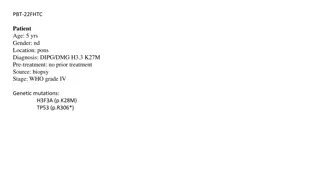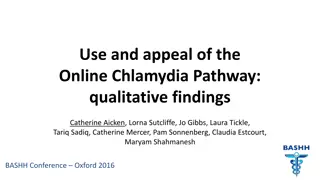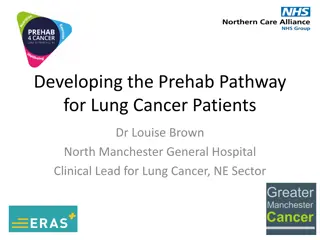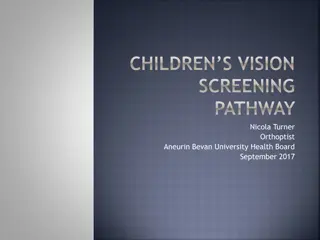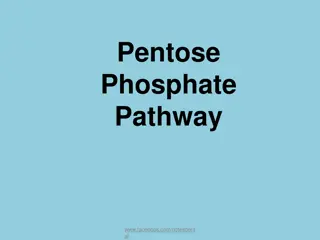Promising Pathway Act for GBM and DMG Challenges
GBM and DMG pose significant challenges due to poor prognosis, impact on daily life, disease complexity, regulatory limitations, and low clinical trial participation rates. The current system fails to provide optimal treatment access, highlighting the need for the Promising Pathway Act to address these barriers and empower experts and patients in decision-making.
Download Presentation

Please find below an Image/Link to download the presentation.
The content on the website is provided AS IS for your information and personal use only. It may not be sold, licensed, or shared on other websites without obtaining consent from the author. Download presentation by click this link. If you encounter any issues during the download, it is possible that the publisher has removed the file from their server.
E N D
Presentation Transcript
Promising Pathway Act With a Focus on Glioblastoma Multiforme (GBM) and Diffuse Midline Glioma (DMG) But Applies to Other Serious Diseases! Al Musella, DPM President Musella Foundation For Brain Tumor Research & Information, Inc Musella@virtualtrials.org 888-295-4740
GBM and DMG: Challenges GBM (Glioblastoma Multiforme) and DMG (Diffuse Midline Glioma) are devastating types of brain tumors with unfavorable outcomes. The landscape of these challenges includes: Prognosis: 1. Patients survive an average of less than a year. Impact on Daily Life: 2. GBM and DMG can cause a range of neurologic problems, such as cognitive impairment, difficulties with memory and attention, motor function challenges, and other neurological symptoms. These issues further impact daily functioning and quality of life for individuals with these tumors. Most patients can never return to school or the same level of work they did before the diagnosis. Complexity of the Disease why can t we cure these now? 3. GBMs and DMGs are characterized by a high degree of genetic diversity, resulting in numerous mutations that can vary even within sections of the same tumor. This complexity presents challenges in treatment strategies as a single therapeutic approach may not effectively address all the mutations present.
4. Regulatory Limitations: The current regulatory system poses challenges for the approval of combination therapies. It often requires each component of a combination to demonstrate individual efficacy, which may not always be feasible or applicable for complex diseases like GBM and DMG. Low Clinical Trial Participation: Only approximately 5-10% of adult GBM patients in the USA enroll in clinical trials. Disparities in participation rates are evident across different socioeconomic groups, age groups, ethnic minorities, and geographical locations. This means that results obtained from trials does not reflect how the treatment works on the typical patients. Regulatory Hurdles for New Treatments: Numerous promising treatments remain untested in patients due to the significant time and financial investments required to navigate the FDA approval process. 5. 6. The rigidity and slow pace of traditional clinical trials can hinder timely access to potentially beneficial treatments for individuals with GBM and DMG. As evidence emerges, the inability to adapt trial protocols or incorporate new findings may limit the exploration of promising therapies and delay their availability to patients. By acknowledging and understanding these challenges, we can foster innovative approaches to improve treatment outcomes, enhance the quality of life, and support individuals diagnosed with GBM and DMG
The Failure of the Current System 1. Blocking Access to Optimal Treatment Advanced Patient Navigation: Utilizing AI and expert teams, we have the most sophisticated patient navigation program ever. Treatment recommendations are personalized based on the patient's condition and preferences. Blocked Access: Tragically, patients are usually unable to access the top recommendations. These are the best options, determined by world- renowned experts, yet the current system denies access. Bureaucratic Barriers: Decisions about treatment should be in the hands of experts and patients, not bureaucrats who have never met the patient. Call to Action: The Promising Pathway Act aims to remove these barriers, putting control back in the hands of those who know best.
Stifling Innovation in Rare Disease Treatment - The High Cost and Time- Consuming Nature of FDA Approval Challenges with Rare Diseases: Bringing innovative ideas for rare disease treatments through the FDA approval process is both expensive and time-consuming. Lost Opportunities: Many promising experimental treatments never see the light of day in the clinic due to these barriers. The Promising Pathway Act: A beacon of hope, this act aims to drastically reduce both the costs and time required for approval. Enabling Innovation: By slashing these barriers, more new and exciting treatments can be explored and implemented, fostering a more innovative and patient-centric approach.
Can early access really help patients? Seven year old Anatole (We have permission from his parents to use his name, story and images) was diagnosed with a DMG in May,2018. He quickly failed all available treatments, was progressing quickly, was wheelchair bound then bed bound. Lost use of half of his body, couldn t walk, or go to school and had severe nausea, dizziness, and vision problems. His only remaining hope was an experimental treatment called Onc-201. He tried to get into the clinical trial, but was denied entry because he was in too bad of a shape. He was told nothing can help him, to go on hospice and he will die in a few months. The drug company did not have an expanded access program at the time so there was seemingly no way to get the drug. We persuaded the drug company to allow us to fund and run an expanded access program, and Anatole was among the first to get access. Now, four years later (average survival is less than a year for this tumor) , he is still on this oral medicine with no side effects and the tumor shrank to about 1/3 the original size. He feels much better. He can not only walk, but goes to school, plays soccer and rides a bike. He is a happy kid. However, our expanded access closed we ran out of funds. There is a trial ongoing that is randomized to a control group that uses an actual sugar pill as a placebo. There are many kids trying to get this treatment and can not get it. We need this PPA approved quickly.
Combination Therapies The cure for these diseases will probably be a combination of treatments. In our expanded access program mentioned on the last slide, about of the kids were helped. We found out why the other were not, and it might be an easy addition of another drug but were not allowed to even try it. That combination has never been used in kids yet the drug company won t allow it until the drug is approved. The current system is not set up to allow for the approval of a drug that is only part of the ultimate cocktail. Each drug has to stand on it s own and show a very high level of safety and effectiveness to get approved before it can be tested in combinations. PPA would allow these treatments to get conditional approval and sets up a learning system that can screen combinations effectively.
Cost There are many promising treatments that are not being developed because the money needed to take a drug from pre-clinical to approval is way too high and the process takes too long. This rules out the chance of ever having a game changing drug made just for a very rare disease. We have many examples. PPA will slash the time and cost needed for a drug to get conditionally approved. This will allow many promising candidates to be tried, and will give our doctors a wide range of choices to use as well as the infrastructure needed to make evidence based decisions on which drugs to use and which combinations to try. Estimated cost and time to go from first in man study to approval and resultant cost of treatment per patient for DIPG (350 patients/year) Pathway Time Cost DIPG Standard 8-12 years $100 million and up $600,000 per patient per year Promising Pathway 3-4 years $10 million $60,000 per patient per year
Right To Try and Expanded Access We advocated for and contributed to the passage of the "Right to Try" act, granting terminally ill patients access to experimental treatments. However, the implementation of this act proved ineffective. Drug companies were hesitant to utilize this pathway, and payment issues posed challenges. Consequently, very few brain cancer patients have benefited from treatments under this program. We also pursued expanded access options, which offered limited assistance in select cases. However, it proved impractical for most patients, and restrictions prevented us from exploring desired treatment combinations. Small companies often avoided expanded access due to financial constraints and concerns about potential side effects derailing their programs. Additionally, doctors face significant time constraints and paperwork burdens, limiting their ability to investigate and facilitate expanded access. Consequently, only a small percentage of brain cancer patients have access to expanded access treatments. Regrettably, the bottleneck now lies with the drug companies and doctors rather than the FDA. In both cases, the absence of outcome tracking requirements resulted in the loss of valuable data. By capturing and analyzing treatment outcomes, we could have gained important insights for future advancements in brain cancer treatments.
Accelerated Approval This is a modification of the standard approval process which allows for the use of a surrogate endpoint instead of a clinical endpoint. A surrogate endpoint speeds up the process by using a measurement that predicts clinical benefit. For example, under the standard approval process, overall survival may be used which may take the trial a few extra years to complete. A surrogate endpoint might be something like a decrease in tumor size on MRI, which is a lot faster to see. This still requires multiple large trials to prove the drugs are safe and effective and the same level of proof as the traditional approval. It also requires a post approval clinical trial, which is usually done in a small number of highly selected patients who use the drug. Sounds good, but in practice we asked the FDA to give Accelerated Approval to a few drugs that had a strong effect and would be perfect to try in combinations, but by themselves did not help the average patient enough, and so the FDA refused. Accelerated approval doesn t work for drugs intended to be used in combinations. They have to stand on their own.
Promising Pathway Act The Promising Pathway Act was introduced into Congress by Senator Braun on 6/8/23 as S 1906 and to the house as HR4408 on 7/6/23 by Rep Gallagher. The text of the bill is available at: https://virtualtrials.org/pdf2023/s1906.pdf It has bipartisan support with these cosponsors (as of 8/21/23): Sen. Gillibrand, Kirsten E. [D-NY] Sen. Wicker, Roger F. [R-MS] Sen. Cramer, Kevin [R-ND] Sen. Murkowski, Lisa [R-AK] Rep. Quigley, Mike [D-IL-5] Rep. Westerman, Bruce [R-AR-4] Rep. Swalwell, Eric [D-CA-14] Rep. D Esposito, Anthony [R-NY-4] Rep. Fitzpatrick, Brian K. [R-PA-1]
Promising Pathway Act Features Applies only to serious or life threatening diseases. Time limited provisional approval. (Up to 8 years). An FDA Advisory Committee will determine if the approval can be converted to a full approval Drugs must demonstrate substantial evidence of safety and early evidence of a positive therapeutic outcome. All patients who use drugs approved under this pathway must participate in a registry, which will be readily accessible to patients and medical professionals to access the aggregated and deidentified data. Patients must undergo consent and release of liability to doctors and drug company. Medicare should pay for these drugs, and other insurances are encouraged to pay for it they are not allowed to deny these drugs for the reason of them being experimental! (Payment part of the bill is under review.) The FDA will not hold use of this pathway against the drug company
Opposition 1. Would lower FDA s approval standard, exposing patients to unsafe and ineffective treatments By definition, this pathway only applies to diseases where there are no safe and effective treatments. Isn t it better to have access to promising treatments when we do not already have proven treatments? Doctors will analyze the clinical trial results and the ongoing data before prescribing a drug and will not prescribe them if they do not think they will help that patient. The FDA can remove the approval as soon as it is apparent that they are not safe or effective. Just because they are allowed to prescribe these treatment does not mean doctors will prescribe them. The doctors are the experts and they should be making the decision on a patient by patient basis not a regulatory board who is trying to keep everyone safe without weighing the risks vs the benefits by individual patient. Under current system, patients have trouble getting access to drugs for years after they are identified as safe and effective.
Opposition 2. Phase 3 trials are the gold standard. True but they are also slow, expensive and inflexible. They stifle innovation. They are absolutely needed when trying to prove a treatment has a small benefit. We are looking for large benefits. There are statistical analyses available now that can replicate the outcome of the major brain tumor phase three trials using registry data, with an immense savings of time and expense. Patients in the registry who do not use the treatment could be used as matched concurrent controls. Phase 3 trials are usually made up of the perfect patients , which means white, urban, middle to upper class, younger and in much better shape than the average brain tumor patient and is in no way representative of the brain tumor patient population. We do not learn how the treatments work in the real world until after approval. Perfect example: of all USA Glioblastoma patients, the average survival is 8 months, but the average survival in the control groups of recent phase 3 trials was over 16 months, which shows the trials have no relation to the real world patients.
Opposition 3. How can we tell if a treatment works without a trial? The 1st chart shows the survival curves of the control groups of the last six large newly diagnosed GBM brain tumor trials. This is actually way better than average patients do, but shows a baseline we can use to judge new treatments The 2nd chart shows unpublished results on a combination for recurrent GBM that will likely get a quick approval under PPA but has been working on the regular approval pathway for over 20 years now. Can you tell which is better?
Opposition 4. You are lowering the standards for drugs. We want better not worse drugs! Just the opposite! The Promising Pathway is a time limited conditional approval. If the treatment proves worthy, it gets full approval. Once fully approved, it will have way more research behind it than the current pathway. And best of all, that research will be on the entire spectrum of patients, not just the perfect patient, and will include combinations which usually do not happen until after a drug is approved under the current pathway. These drug HAVE to prove a benefit over existing drugs to get full approved. Two of the more recent approvals for brain tumor treatments resulted from NO survival benefit over existing treatments in phase three trials. It is voluntary to use drugs approved under this pathway. You can still limit yourself to those drugs fully approved if you do not want to take the risk. However, the risk is no different than if you were entering a phase 3 clinical trial and we now consider clinical trials as the standard of care. Who should be making the decision of if you should be able to use a drug: your doctor who knows you and your case, and is working in your best interest and can explain the risks and possible benefits to guide informed evidence based decisions, or a bureaucrat who doesn t know you and is trying to protect you from harm over trying to cure you?
Expected results We expect a few brain tumor drugs to get approved quickly after the act is approved, then a few more every year. Our patient navigation program will be able to create virtual trials of combinations of these drugs and monitor the outcomes. Doctors will be able to finally use their brains and think up new combinations and treat patients as individuals instead of sticking to a guideline with many drugs to choose from. Results of these N of 1 trials will be tracked in the registry! Drug prices should eventually drop r at least remain stable as competition among drugs increases and the cost of getting a drug approved plummets. Without PPA, new drugs will have to skyrocket. We should be able to drastically speed up the search for the cure! The amount of research on each drug dramatically increases as every patient who uses the treatment are followed in a virtual trial.
Summary Think of it this way: This bill will give you and your doctor the OPTION of using conditionally approved drugs. The data will be available and intelligent evidence based decisions can be made. If there is not enough proof of benefit or safety the drug won t be used. This does not force you to use these drugs. The level of risk is the same as entering a phase 3 trial. For the first time in history, we will know how a treatment performs in the real world as every patient is tracked in a learning system. It is possible that a bad treatment gets conditionally approved. That has happened in the past even with the full approval process. However, under Promising Pathway Act, since all patients are tracked we will eliminate them quickly. No more patients would be harmed than if the phase three trial was done instead.

 undefined
undefined








